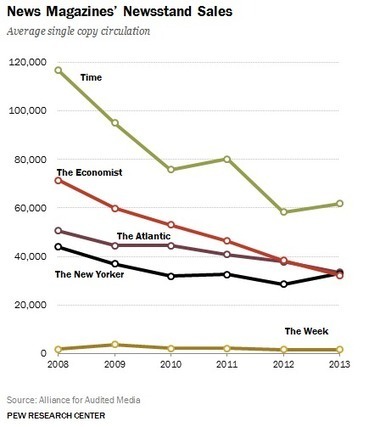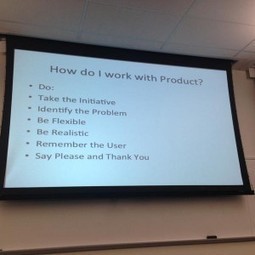 Your new post is loading...
 Your new post is loading...
Despite great strides, journalists around the world are not keeping pace with the transformations of the digital era. That is the conclusion of the first-ever global study on how news media are adopting new technologies, conducted by the International Center for Journalists (ICFJ). Against this background of immense challenges for the news industry, there is some good news: Digital news is making tremendous headway worldwide. The journalism community has long discussed how the digital revolution is impacting news media. Our study, The State of Technology in Global Newsrooms, focuses on a missing link in this debate: What technologies are journalists around the world using and how? We conducted the survey in 12 languages, and heard from more than 2,700 newsroom managers and journalists from 130 countries. This massive response identifies specific challenges the industry faces: a technology gap, unmet training needs, lack of audience engagement, concerns about building trust, an information security shortfall, and new revenue streams. The study also identifies the digital leaders and laggards....
It was a case study in the difficulty of covering national political conventions, hurry-up-and-wait affairs that feature a tricky combination of canned speeches and bouts of breaking news at nearby protests. Even in an epicenter of media scrutiny, it's impossible for news organizations to have someone at every street corner. That's why, when the Republican National Convention kicks off in Cleveland Monday, BuzzFeed will have a reporter in everyone's pocket. On Sunday, BuzzFeed launched BuzzBot, an automated chatbot for Facebook's Messenger app. The bot, developed by BuzzFeed's Open Lab (an R&D skunkworks based in San Francisco), is capable of having a limited back-and-forth with users to gather news about the convention throughout the week.It works like this: Users can open up the Facebook Messenger app and search for BuzzFeed News (or follow this link) to open up the dialogue. Then, BuzzBot will begin asking users a series of multiple-choice questions related to the convention: Are they following the news? If they live in Cleveland, are they attending, protesting or living there?...
According to data published by the Reuters Institute for the Study of Journalism, very few people consider print newspapers their main source of news anymore. Today's most important news sources are television and online media, with social networks taking on an increasingly large role in people's news consumption.
As people turn to other media outlets as their primary source of information, print newspapers are probably best advised to accept their new role and focus on their core strengths, which are local reporting, investigative journalism and in-depth analyses of national and global affairs.
This chart shows which news sources people from five different international markets consider the most important one to them personally....
To close out 2014, we asked some of the smartest people we know to predict what 2015 will bring for the future of journalism. Here’s what they had to say.
...Such missteps are not surprising. People living through a time of revolutionary change usually fail to grasp what is going on around them. The American news business would get a C minus or worse from any fair-minded professor evaluating its performance in the first phase of the Digital Age. Big, slow-moving organizations steeped in their traditional ways of doing business could not accurately foresee the next stages of a technological whirlwind.
Obviously, new technologies are radically altering the ways in which we learn, teach, communicate, and are entertained. It is impossible to know today where these upheavals may lead, but where they take us matters profoundly. How the digital revolution plays out over time will be particularly important for journalism, and therefore to the United States, because journalism is the craft that provides the lifeblood of a free, democratic society....
F...It may have been coincidental, but around the time this new truism started sinking in, we began to see investment in businesses both new and old that promised serious journalism. Facebook cofounder Chris Hughes bought The New Republic; Jeff Bezos bought The Washington Post; eBay billionaire Pierre Omidyar pledged $250 million to fund First Look Media, which hired Glenn Greenwald, one of the reporters who broke the Snowden revelations in The Guardian. Vox Media, home of tech site the Verge, raised $38 million and BuzzFeed $35 million in new rounds of funding.
With money has come innovation, both in journalism itself and in the tools to produce it. When Ezra Klein left the Post's Wonkblog for a new site funded by Vox Media, it was in part because Vox had built a sophisticated content management system designed with mobile readers in mind. Atavist—founded by WIRED alumni Evan Ratliff and Nicholas Thompson as a net-native platform for magazine-style journalism—built a similar platform that it licenses to other publishers. Such tool sets make it simple to create a seamless mix of text, video, music, maps, charts—a mix that, done right, spells the difference between just reading a story and taking a deep dive. Now this kind of enhanced storytelling is turning up in places beyond journalism, like the Brookings Institution's Brookings Essay, an online series typified by historian Margaret MacMillan's 7,000-word thought piece on the parallels between 1914 and 2014....
Travel agent. Meter reader. Newspaper reporter.
They’re all among CareerCast’s 2014 list of endangered jobs, with the hiring outlook for newspaper reporter positions expected to drop 13 percent by 2022, according to the company’s forecast.
“Declining subscription and dwindling advertising sales have negatively impacted the hiring power of some newspapers, while others have ceased operations altogether,” the company writes in a 38-word epitaph for the field.
“Online outlets continue to replace traditional newspapers, and the long-term outlook for newspaper reporters reflects the change.”...
BYA decade ago, aspiring journalists could just think about journalism and leave the financial side to others. Now, to be a successful journalist you have to think like an entrepreneur and understand something about the business you’re in.
There have been some ups and downs, to say the least. In the early days, we had the lonely thrill of being “Web pioneers.” Back then, we developed some of the key forms and hallmarks of digital media: news aggregation, blogs, slideshows, the more personal, conversational tone of Web writing and headlines. In 1998, we were the first news site to try a paywall. In 1999, we were the first to get rid of one.
A land rush doesn’t mean serious journalism has turned into a great business. But talent and money flocking to our trade is preferable to a wholesale exodus....
We don’t typically write about intra-newsroom politics at Nieman Lab, leaving that to Manhattan’s very capable cadre of media reporters. But Abramson’s removal and Dean Baquet’s ascent has apparently inspired someone inside the Times to leak one of the most remarkable documents I’ve seen in my years running the Lab, to Myles Tanzer at BuzzFeed.
It’s the full report of the newsroom innovation team that was given six full months to ask big questions about the Times’ digital strategy. (A summary version of it was leaked last week, but this is the big kahuna.)
The Pew Research Center’s Journalism Project has released its 11th State of the News Media report. A comprehensive “document,” it covers TV, newspapers, magazines, radio and digital.
I won’t try to summarize the full sweep of this “best of times, worst of times” report. However, below I’ve excerpted a few key findings and charts that provide a snapshot into where things stand in US journalism and news consumption....
Last month, venture capitalist Marc Andreessen posted what, in his view, was the future of the news business. Reactions were varied, but everyone had one. I joked that my entire Twitter stream was people replying to Andreessen as he has very publicly thrown himself into the future of news conversation.
We need new voices in this discussion like Andreessen, but his post was too… nice. I’d bet he left his more candid insights out. After the post, I found myself wishing someone would share more actionable observations from the industry.
So, here’s my take. Each one of these could be their own essay. Please argue with me....
...I should end the year on an upbeat note, shouldn’t I? But Time Inc. ruined it. The surrender of journalism to advertizing and public relations – not alliance with, but surrender to – was the biggest media story of 2013 that the media almost didn’t cover at all. But it’s right there in black and white, if buried on the slowest news day of the year:
Time Inc. will abandon the traditional separation between its newsroom and business sides, a move that has caused angst among its journalists. Now, the newsroom staffs at Time Inc.’s magazines will report to the business executives. Such a structure, once verboten at journalistic institutions, is seen as necessary to create revenue opportunities and stem the tide of declining subscription and advertising sales...
If you want to peer into the future of journalism, do yourself a favor and look to Jay Rosen's Studio 20 journalism program at NYU. Sure, I may be biased: I graduated from the program in 2011.
...Glass also underlines the frustrations of working on someone else’s platform, on their rules. Hogan imagines that one of the most effective uses of Glass is livestreaming. But despite the fact that Glass is technologically capable of livestreaming, Google refused to unlock the feature, even after numerous pleas from Hogan and the team at Thunderdome.
Where Google Glass really shines is in capturing first-person experiences. Last October, the Stanford basketball team wore Google Glass during warmups to show fans what it’s like to be a player on a top-tier NCAA program. Experiments like these may not be Pulitzer-worthy. But imagine the same technique used in a riot or a warzone. It might require some editing and packaging, but visceral first-person footage has the potential to be extremely powerful....
|
The publication of the annual Digital News Report, from the Reuters Institute for the Study of Journalism at Oxford University, is eagerly awaited by news execs around the world. So much so, that the 2017 study is being accompanied by major presentations on June 22 at the GEN Summit in Vienna, and at the Tow Center for Digital Journalism at Columbia University in New York. Clocking in at 133 pages, this sixth annual study, has been expanded to cover 36 different markets around the world (the first, in 2012 examined just five countries), shedding light on many countries – including nations featured for the first time such as Mexico, Malaysia, Croatia and Romania – which are seldom reported in English-language media. Against this backdrop it’s fascinating to determine some of the similarities – and differences – between digital news habits in the U.S. and the rest of the world. With that question in mind, here are seven important developments worth highlighting....
Did a robot write this article? No, but it could have. This isn’t the plot of a dystopian Philip K. Dick novel, but an emerging journalistic reality. You may already have read material produced by a machine without even realising it. To adapt William Gibson, “the robo-journalism future is already here – it’s just not very evenly distributed.” So how might this technology evolve? And as journalists, should we consider robo-journalists friends or foe? The Associated Press (AP) revealed in January 2015 that it “is now automatically generating more than 3,000 stories about U.S. corporate earnings each quarter.” It noted that this represented “a tenfold increase over what AP reporters and editors created previously.”...
For traditional media companies looking for an alternative, Blendle may have an answer. The website essentially acts as “Spotify for journalism.“ It’s a reinvention of the newsstand, built for the Internet, where readers pay by the article instead of per issue or through a monthly subscription.
This all occurs seamlessly in a way that prioritizes the user: your credit card information is stored on the site for easy payment, and an unorthodox refund option allows users to get their money back if they’re not satisfied with the piece.
Traditional publishers seem to be excited by Blendle’s potential to provide a desperately needed new revenue stream. The New York Times (a Blendle investor), the Wall Street Journal and the Washington Post have already signed up, and more American publishers are likely on the way...
In my ‘digital thinking’ class, the goal is for students to emerge fully literate in the changes affecting journalism. Here are the main currents and trends that I expect them to master by the close of the term.
For each, they should understand: What it means, why it’s important, and where things are going with it. I’ve added a link or two to help get you started. And I’m happy to receive your comments about what’s missing from this list....
...Imagine, though, if it turned out that serious news consumers didn’t care about that stuff. Not just teens or those who get all their news from Buzzfeed lists and trending hashtags — but if actual, grown up readers didn’t give a flying toss about church and state.
If that were the case there’d be nothing to stop every financially-challenged newsroom (i.e. every newsroom in the world) from joining the race to the bottom: Selling every headline to the highest bidder, giving every book a positive review (with an affiliate link at the bottom, of course, or even becoming a full-fledged ecommerce company. News organizations, after all, are supposed to serve their readers, and if readers want a completely bought-and-paid-for news agenda, how long will it be until they get their wish?
Judging by the depressing reaction to the Bezos-owned Washington Post’s move to insert giant Amazon affiliate buttons into its news stories, that future might not be far off....
The Reuters Institute Digital Report reveals new insights about digital news consumption based on a representative survey of online news consumers in the USA, UK, Germany, France, Denmark, Finland, Spain, Italy, Urban Brazil and Japan.
This year's report reveals new insights about digital news consumption based on a YouGov survey of over 18,000 online news consumers in the UK, US, Germany, France, Italy, Spain, Brazil, Japan, Denmark and Finland.
This website contains data about the growth of tablets and smartphones, generational and country based differences in media usage. Also analysis on the role of impartial news in a digital world and the role of social media in finding and distributing news....
...Chief among the findings was that many young consumers craved more in-depth news but were unable or unwilling to get it. “The abundance of news and ubiquity of choice do not necessarily translate into a better news environment for consumers,” concluded the researchers in their final report. “Participants in this study showed signs of news fatigue; that is, they appeared debilitated by information overload and unsatisfying news experiences .
. . . Ultimately news fatigue brought many of the participants to a learned helplessness response. The more overwhelmed or unsatisfied they were, the less effort they were willing to put in.
”The idea that news consumers, even young ones, are overloaded should hardly come as a surprise. The information age is defined by output: we produce far more information than we can possibly manage, let alone absorb..
A new survey from Dutch company ING found that 45 percent of international journalists “publish as soon as possible and correct later,” while only 20 percent always do their due diligence before publishing.
Additionally, the 2014 Study Impact of Social Media on News report, created for PR professionals and journalists, reported that one-third of journalists don’t consider social media posts a reliable source of information. Still, 50 percent said the majority of their news tips and facts come from social.
But journalists don’t seem to mind questions of accuracy too much, since 60 percent said they feel less restricted by journalistic standards in their social media reporting. Twenty-two percent reported that they treat social media posts the same way as traditional methods when it comes to journalism ethics....
A 96-page internal New York Times report, sent to top executives last month by a committee led by the publisher’s son and obtained by BuzzFeed, paints a dark picture of a newsroom struggling more dramatically than is immediately visible to adjust to the digital world, a newsroom that is hampered primarily by its own storied culture.
The Times report was finalized March 24 by a committee of digitally oriented staffers led by reporter A.G. Sulzberger. His father, Times Publisher Arthur Sulzberger, fired Executive Editor Jill Abramson Tuesday, a decision that doesn’t appear immediately related to the paper’s digital weaknesses.
The report largely ignores legacy competitors and focuses on the new wave of digital companies, including First Look Media, Vox, Huffington Post, Business Insider, and BuzzFeed....
Pew's annual omnibus report finds that the transition to digital, and the influx of new money and new ideas, only represents a sliver of activity in the broader media.
In Pew Research Center’s latest State of the News Media report, just out, you get a glimpse of how the worlds of journalism and technology are continuing to merge and the impact that convergence has on the business and editorial prospects of media companies.
A majority of Americans now say they get news through a digital platform: 82 percent reported using a desktop or laptop, while 54 percent got news through mobile devices, according to Pew. Half of social media users share or repost news stories, while 46 percent discuss news on those sites. Audiences are also spending more time watching their screens: 63 percent of U.S. adults now watch online video, and of that, 36 percent watch news video.
At the same time, the companies that are helping to redefine digital news are expanding aggressively: Pew estimates that digital news operations, from the small hyperlocal shops up to the likes of ProPublica, The Huffington Post, and Vice have produced almost 5,000 full-time editorial jobs. Not enough to make up for a decade of losses in newspapers, but significant....
Industry experts from the BBC, CNN, ITV News, Trinity Mirror and The Washington Post share their predictions for the key trends in digital journalism this year.We asked five industry experts from local, national and international news outlets to share their predictions for digital journalism in 2014.
The 10 key trends they identified include short-form video, private social media, drone journalism, responsive design and new apps and devices...
Newspapers are dying. But their front pages aren’t.At a time when print advertising revenue continues to decline and publications are laying off staff in droves, newspaper covers are increasingly being shared digitally — helped along by the ease of posting on Twitter, Facebook and other social media platforms.But why? More than anything, these A1s are seen as an encapsulation of a historical event, to be seen and filed away for a distant time when we want to remember how much something mattered in its day...
|



 Your new post is loading...
Your new post is loading...





































This piece is co-authored by Sharon Moshavi and Fatima Bahja. Despite great strides, journalists around the world are not keeping pace with the transformations of the digital era.